Free shipping for all orders over 35 euro!
-
Shop
- Insights
-
About ROMBO
- Dealers
- Guitar Pick finder
- Gift Card
+Categories
- accessories
- bass
- bass pick
- bass picks
- bass plectrum
- bass plectrums
- beginner
- bright tone
- chose guitar pick
- chose guitar picks
- chose plectrum
- chose plectrums
- CrystalBright
- Diamond
- Diamond pick
- discipline and guitar
- DIY generation
- durability pick
- durable pick
- eco
- ecoblack
- find guitar pick
- find plectrum
- fingers vs picks
- grip
- grip guitar pick
- guitar accessories
- guitar advantages
- guitar benefits
- guitar career
- guitar health
- guitar injury
- guitar learn
- guitar lesions
- guitar lesson
- guitar method
- guitar noise
- Guitar noise plectrum
- guitar pain
- guitar pick
- guitar pick beginner
- guitar pick bevel
- guitar pick buy
- Guitar pick diamond
- guitar pick durability
- guitar pick durable
- guitar pick eco
- guitar pick features
- guitar pick grip
- guitar pick material
- Guitar Pick Noise
- Guitar Pick online
- guitar pick recycled
- guitar pick recycled material
- guitar pick special features
- guitar pick textures
- guitar pick thickness
- guitar pick variable thickness
- guitar picks
- guitar tone
- guitar warm-up
- guitarpick
- guitarpicks
- hold a guitar pick
- hold guitar pick
- hold guitar picks
- hold pick
- hold plectrum
- hold plectrums
- how to
- how to chose your guitar picks
- jazziii
- learn guitar
- lose guitar pick
- material
- materials
- mental health and guitar
- motivation and guitar
- music
- not to lose guitar pick
- Online guitar
- online guitar pick
- online guitar pick buy
- pick
- pick durability
- pick material
- pick noise
- Picks
- picks vs. fingers
- play bass fingers
- play bass picks
- play bass with fingers
- play bass with pick
- play bass with picks
- play bass with plectrum
- play guitar faster
- plectrum
- plectrum attributes
- plectrum beginner
- plectrum bevel
- plectrum characteristics
- plectrum features
- plectrum grip
- plectrum material
- plectrum noise
- plectrum recycled
- plectrum shape
- plectrum variable thickness
- plectrums
- Plek
- pua
- recycled
- recycled guita pick material
- recycled guitar picks
- recycled picks
- recycled plectrum
- Rombo Diamond
- rombopicks
- tendonitis guitar
- the guitar pick
- tone
- variable thickness
- warm tone
- warm-up guitar

7 Essential Guitar Pick Techniques
One of the most valuable skills when it comes to guitar playing is versatility.
Versatility allows you to adapt to different environments and enriches your playing, making a difference in the final result.
Music is about staying dynamic and monotony kills dynamic. Therefore, the most logical step for you as a guitarist is to expand your repertoire of guitar skills to keep that vital, engaging sound that makes music so joyful.
If you have decided to use a guitar pick for playing guitar, there are seven techniques that are a must.
They will take time to learn and master, but believe me, they make the difference.

1- TREMOLO PICKING:
If you have listened to the music of the last 70 years, you can probably recognize this guitar technique in most rock classic hits.
Tremolo is an Italian word which means “to shake” or “to tremble”.
In the context of guitar, it involves striking one (sometimes more than one) guitar string very fast with alternating strokes. Therefore, this technique is a form of alternate picking. Tremolo picking is very easy to learn but it requires strong discipline and practice to master.
Tremolo picking is essentially useful for any style of music and obviously a big part of the surf guitar sound (I’m a big fan of it!).

In guitar literature, sometimes the words tremolo and vibrato are reversed. This technique has nothing to do with a “tremolo bar” or a "tremolo effects box".
WHY IS TREMOLO PICKING IMPORTANT?
If one of your long-term goals in your guitar learning process is to increase speed, tremolo picking is a good place to start.
It is not only very fun but also can add new textures and some dynamics to your compositions. You would be surprised how well this technique fits even in metal or hardcore music.
A FAMOUS SONG WITH TREMOLO PICKING:
The surf rock version of the song “Misirlou”, from Dick Dale, is probably the greatest example of tremolo picking. The original one is a traditional song from the Eastern Mediterranean area dating back to 1927!
The version of Dick Dale got very popular after appearing in the soundtrack of Pulp Fiction in 1994.
BEST PICK FOR TREMOLO PICKING:
The most influential factors when choosing the best guitar pick for tremolo picking are thickness, material, and grip.
It’s important to have a snappy, responsive guitar pick. For this, medium picks with a medium/pointy tip are my recommendation.
However, there is no consensus in the guitar world for this. Many players have reported preferring thick, rigid picks.
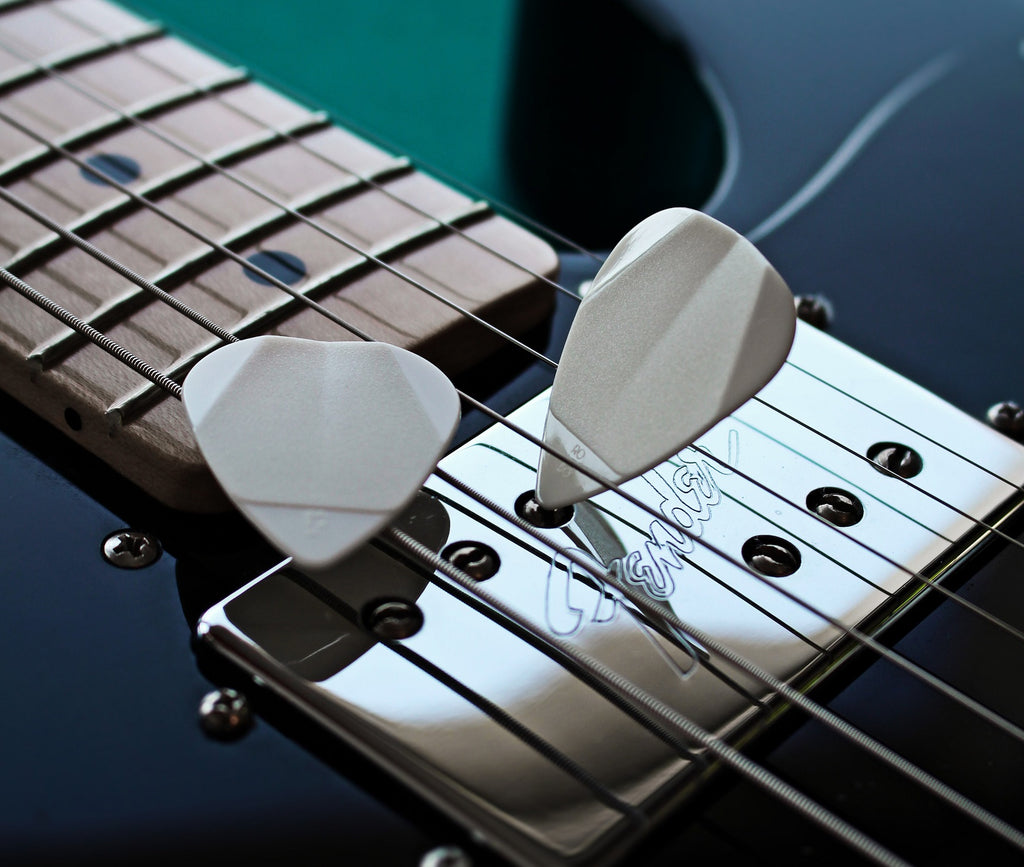
In my case, I have found the best stability and speed using Rombo Origami. This pick can be described as: Flexible but still rigid enough for note control. Right amount of flexibility for a snappy fluid attack that's bright and crisp. The concave surface on the hold area ensures an ergonomic and comfortable hold.
Everyone’s hand is a little different in how they hold the pick and move. The best way to find out is to test different shapes and thicknesses, and then try them out
Good luck!
2- PICK SLIDES:
One very extended technique often performed in the rock, metal, and punk genres is pick slides or pick scrapes.
By holding the edge of the guitar pick against the guitar strings and moving it along the edge, the pick catches the strings’ windings, causing the strings to vibrate and produce a very pleasant textured noise.
Usually, guitar pick slides start near the bridge and end over the higher frets. However, there are countless variations of pick slides depending on the direction, the angle of the pick relative to the strings, and other variables.

Unfortunately, performing pick slides completely ruins the edges of the guitar pick, especially on thinner ones. This won’t directly affect the tone or control of the plectrum, but the damaged sides will develop some dents.
What makes a guitar pick durable? Find our here.
WHY ARE PICK SLIDES IMPORTANT?
Guitar pick slides are not the most relevant aspect of your playing. Nevertheless, a correctly performed slide in the right place will add so much to the moment.

The noisy textures produced by this technique are the perfect weapon of choice for songs using high distortion levels.
A FAMOUS SONG WITH PICK SLIDES:
The first use of the pick slide is attributed to Bo Diddley and can be heard in the opening of his song "Road Runner" from the 60s.
Today, some guitarists have taken this technique to a new level and have created signature variations. A shining example of pick slides from the last years is the metal band Gojira with their famous signature “Gojira-Scrape” that was created by accident and combines several guitar pick techniques
BEST PICK FOR PICK SLIDES:
If you are going to do pick slides frequently, then you need to consider two things:
- Using durable guitar pick materials, and
- Using thick picks.
Otherwise, your guitar picks will be inoperative after a couple of sessions. The dilemma is that most players get better noisy sounds with a medium guitar pick.

I have found a solution that works for me: medium-heavy picks that are large enough to scrape with higher areas of the pick that won’t touch the strings. From our picks, I prefer Rombo Horizon the most for pick slides. Also, the curvy edge creates different pressure on different strings and that’s nice.
3- PINCH HARMONICS:
Do you know any guitar player who does not like pinch harmonics? I do not either.
Pinch harmonics are created by the picking hand. Playing this technique produces high-pitched tones. This phenomenon occurs when you stop a part of the string vibrations in the right position and create a "node".

There is a simple way to test this; pick a note and apply a small pressure anywhere on the string such that the vibration doesn’t stop completely.
WHY ARE PINCH HARMONICS IMPORTANT?
Pinch harmonics are often related to high gain tones and metal music but they are a powerful tool to add dynamics and textures to any genre of music or type of guitar; electric or acoustic.
It is considered one of the most abstruse techniques for intermediate players. Common problems are pinch harmonics that aren't loud enough or additional noises that make the harmonics not sound clean enough.

Root causes of this problem can be:
-
the guitar player does not know the right places on the strings to play pinch harmonics
-
there is unwanted noise coming from unmuted strings
-
the pinch harmonic is produced isolated, without combining it with other techniques like vibrato.
Most guitar players (including me) played their first pinch harmonic accidentally.
A FAMOUS SONG WITH PINCH HARMONICS:
Guitarist Billy Gibbons from ZZ Top is considered the father of pinch harmonics. Not because he invented them, but because he brought them to the mainstream. Although he is a well-rounded guitarist with a focused skillset based on blues, he is best known for his pinch harmonics.
BEST PICK FOR PINCH HARMONICS:
There is no special pick to do pinch harmonics. The pinch harmonic is technically produced by the thumb of your picking hand.
However, this technique is widely used in lead guitar in combination with other advanced techniques that work especially well with thick, small guitar picks.
Therefore, although you can learn pinch harmonics using thin picks, I recommend using thick picks.
 #If you want to learn more about the differences between thin and thick guitar picks read our article "Thick guitar picks vs thin guitar picks".
#If you want to learn more about the differences between thin and thick guitar picks read our article "Thick guitar picks vs thin guitar picks".
4- PALM MUTE:
Palm mute is a very regular technique used by most guitarists. By placing the side of the picking hand on the strings close to the bridge and dampening the guitar strings (when necessary), the strings produce muted sounds.
You can control the dampening effect by moving your hand to a different position further from the bridge.

Although this technique isn't seen as a very difficult one, these are common mistakes that prevent players from learning it properly:
- wrong hand position
- not having a relaxed posture
- problems by keeping a stable tempo
- too much pressure on the strings
WHY IS PALM MUTE IMPORTANT?
As a guitarist or bassist, you are always on the lookout to make your music sound natural, creative, and exciting.
Palm-muting is a great skill for dynamic control exercises. This means you will automatically learn how to shape your sound using fluctuations in volume and intensity.
With this skill in your repertoire, your music will sound more vocal and dynamic.
A FAMOUS SONG WITH PALM MUTE:
This technique is very old. As old as the invention of the electric guitar (1936). Most classical players have been using it for centuries with all kinds of instruments.
Today, palm muting is widely used in heavy metal, thrash, speed, and death metal. It is often found in music that features distortion effects.
Is there any good song to practice palm muting for getting better at it? “Master of Puppets” from Metallica—it’s a masterclass in palm muting and down picking.
BEST PICK FOR PALM MUTE:
I recommend using a thick guitar pick for this. They provide high volume, a broader dynamic range, and more control over single notes (in case you use palm mute arpeggios). In addition, palm muting is a demanding technique that causes a lot of guitar pick wear. As you might know, thick guitar picks are more durable.

My favorite choice for this technique is Rombo Diamond.
5- PICK STRUMMING:
Guitar pick strumming is a way of playing guitar. A strum is a sweeping action where a pick (or finger!) brushes over the guitar strings and generates sounds.
For most guitar players, this is the first technique they learned and the technique that caused most headaches as a beginner.

Learning how to strum correctly takes time and practice. Most beginners lack the necessary muscle memory it takes to play while remaining relaxed or having a good posture.
WHY IS PICK STRUMMING IMPORTANT?
In many ways, understanding this skill is essential for understanding guitar. Great strumming skills mean being a great rhythm guitarist. Therefore, this should be your number one goal as a beginner.
Learning chords is important, but they are just static shapes. The diversity of the hundreds (if not thousands) of strumming patterns available will inject musicality and rhythm into your playing.
A FAMOUS SONG WITH PICK STRUMMING:
“Bad moon rising” by Creedence Clearwater Revival, is a good place to start. It combines easy chords (D, A, G) with a very simple progression and a very catchy, bluesy melody.
BEST PICK FOR STRUMMING:
My best advice for beginners is to start with a very thin guitar pick. It can help to practice with something below 0.6 that’s nice and bendy. As you improve your skills, you can try with thicker picks, as they will add more bass to your tone.

For all the beginners out there, my best choice would be Rombo Classic.
However, if you are in the very beginning of your guitar journey, please read this article where I explain, why starting with medium guitar picks can be a better choice for you. "Medium Gauge Guitar Picks".
6- DOWNPICKING
Downpicking or down-stroke picking is a very beloved guitar technique in which the player moves the guitar pick only in a downward motion. The tip of the pick does not brush the strings as the hand moves back to the original position for the next down-stroke.
It is one of the most underrated skills on guitar and although performing this technique might seem easy, the required endurance for long passages with fast tempo is very often a problem even for advanced guitarists.

WHY IS DOWNPICKING IMPORTANT?
But first, why would you want to remove the upstrokes (alternate picking) and then increase the necessary effort for the same number of strokes? Why would you torture your wrist muscles in this way?
This technique is widely used in metal and punk guitar and the main reason is that when mastered, downpicking can make the guitar’s sound very powerful and rhythmic.
A FAMOUS SONG WITH DOWNPICKING:
Famous punk guitarist Johnny Ramone used this technique in the mid-70s in combination with fast tempo (180 to 200 bpm). The technique was very innovative at that time and influenced many current guitarists like James Hetfield who has been regarded as “the King of Downpicking”.
Many beginner guitarists start with songs from Ramones because of their simplicity in terms of chords and lack of tempo variations.
BEST PICK FOR DOWNPICKING:
For downpicking, there is a basic rule: the more mass the guitar pick has, the thicker and more aggressive the sound.

Therefore, a thick, large guitar pick with a pointy tip will be the loudest and most rhythmic one.
I recommend Rombo Diamond.
7- HYBRID PICKING
The interesting thing about hybrid picking is the fact that the player uses a plectrum as well as one or more fingers. This can be done alternately or simultaneously.
Typical styles for this technique are rockabilly guitar, country and bluegrass, and more classical passages with acoustic or classical guitar.
Hybrid picking can be very hard if you are a beginner. Before you think of learning this technique, you will have to learn how to play with your fingers and with a guitar pick. This is a requirement you cannot avoid.

WHY IS HYBRID PICKING IMPORTANT:
Three major arguments should convince you to learn hybrid picking:
Tone diversity:
The pick is generally used to play bass notes with a longer duration and very noticeable timbral differences caused by variations in the vibration of the strings. Therefore, your playing will sound more interesting combining pick and fingers.
Timing:
Hybrid picking allows you to pick two to four strings simultaneously. This makes it very different from strumming and gives an approach much more similar to piano techniques.
Flexibility:
Managing this technique, you will be able to change between fingerstyle playing and guitar pick playing within the same song or passage.
A FAMOUS SONG WITH HYBRID PICKING:
Hybrid picking was popularized by guitarists like Steve Howe some decades ago. Most players that learn this technique today start with a more classical approach.
A great song to start with this technique is “Amy” by Tommy Emmanuel. However, the complexity of the chords makes this song only possible to play for intermediate and advanced players.
BEST PICK FOR HYBRID PICKING:
There is no such thing as a “good” or “bad” pick for hybrid picking. You can use the pick you think fits the best for the song you are playing.
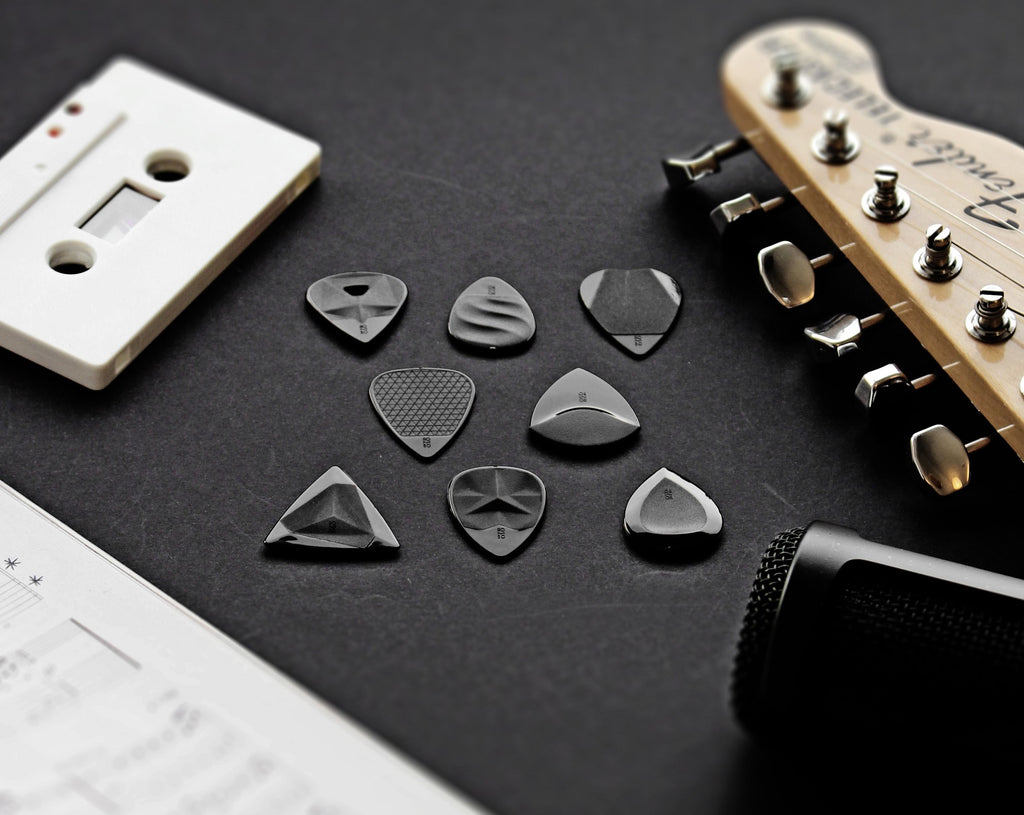
Because this technique is widely used by rhythm guitarists, there is a consensus that picks around 1 mm will perform well. However, it is up to you to try and decide which one is best for every passage.
Discover more about guitar pick thickness here.
8- BONUS SKILL – SWEEP PICKING:
For some reason, sweep picking is the trend. Every guitar forum gets new threads with this topic week after week. Perhaps it’s due to the high speed and visually nice arpeggios that make the guitar produce cyclical sound patterns and put us in a status of trance.

This technique describes the action of playing single notes on consecutive strings using the same motion, either all down-strokes or all upstrokes.
Sweep picking has been recognized as a difficult technique. It is more for advanced players and it can take years to master it.
WHY IS SWEEP PICKING IMPORTANT?
Sweep picking is used by guitarists to play arpeggios at high speed. The phrasing sounds produced by this technique sounds typical of other instruments like the piano.
Although sweep picking is a very important technique for building speed and fluency on string instruments, my advice would be to not learn this technique unless you have mastered other techniques that can give you more versatility.
Sure, it is ok to use sweep picking occasionally but that is not what you are going to play most of the time. In my opinion, a lot of bands overuse this technique. Therefore, you should reflect if the time needed to correctly learn sweep picking could be used for other more relevant skills.
A FAMOUS SONG WITH SWEEP PICKING:
Although often regarded as a “modern guitar technique”, pick sweeping has been around since the 50s. The technique was first used and developed by jazz guitarists.
Today, it is commonly used in metal but many students start with the song “Give Me the Night” by George Benson. Practicing sweep picking with clean tones can help you develop a more accurate technique.
BEST PICK FOR SWEEP PICKING:
What qualities are you looking for in a pick to perform sweep picking? Small and easy to handle, good maneuverability and stability, and good string separation. This means: Thick, pointy guitar picks like Jade or Horizon.

However, I have a bonus for you: We have received some E-Mails from professional guitarists using Rombo Prisma for their sweeping techniques, a pick that wasn’t developed for this. However, its sharp tip, combined with a very large, beveled edge, and the total “mass” of the pick (variable thickness), makes this pick a great candidate for bright tonal sweep picking solos.


Medium Gauge Guitar Picks
Medium guitar picks are the most popular choice amongst guitarists and they offer the best of both worlds, right? Well, it is not that easy.

In our last article, “thin vs thick guitar picks”, we discussed both guitar pick thickness ranges in depth. Medium guitar picks deserve a separate analysis.
1- Why does guitar pick thickness matter?
Guitar pick thickness is usually measured in millimeters and this is an attribute that can change various aspects of a pick like flexibility, tone, volume, pick noise, durability, control over single notes, and more.

The thickness of a guitar pick is for this reason considered one of the 4 fundamental attributes of a guitar pick, along with guitar pick material, shape, and size.
2- Medium guitar pick thickness:
Medium guitar picks range in thicknesses from 0.55 and 1 mm.
The following is what a survey performed in March 2021 has shown. Thousands of guitarists were asked to define the following pick thicknesses:
- The maximum thickness of a thin guitar pick
- The minimum thickness of a thick guitar pick
With both limits established, we obtain the thickness definition of medium guitar picks.

The maximum thickness of a thin guitar pick was defined as about 0.55 mm by 2.292 guitarists.
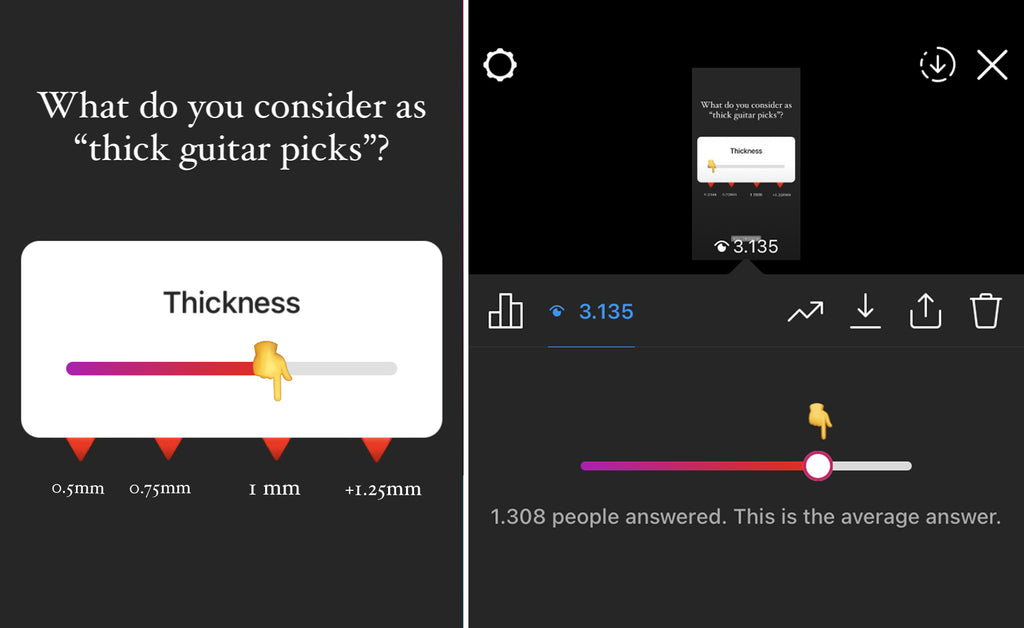
The minimum thickness of a thick guitar pick was defined as 1 mm by 1.308 guitarists.
3- What is a medium guitar pick?
Medium guitar picks are guitar picks with a thickness between 0.55 and 1 mm. These guitar picks are very popular because of their versatility; in some areas, they offer the advantages of both thin and thick guitar picks.

Medium gauge picks have the broadest flexibility range. In this pick thickness interval, the material will play the most important role when it comes to defining the flexibility of a pick.
In other words, thick guitar picks are always stiff and rigid. With thicknesses over 1 mm, even the most flexible pick materials are stiff, and therefore the material has less influence on the flexibility of the pick. This relation creates a broad flexibility range amongst medium guitar picks, which can be very flexible or very stiff, depending on the material used.

The same effect can be applied to tone, durability, and pick noise.
Typically, medium guitar picks are used by lead guitarists who also implement rhythm guitar techniques and look not only for an all-round compromise between single-note melodic phrases and strumming, but also potentially developing a more versatile guitar career that integrates different techniques and mixes both worlds together.
4- Thin, medium and thick guitar picks:
|
|
Thin guitar picks (under 0.55 mm) |
Medium guitar picks (0.55 - 1 mm) |
Thick guitar picks (over 1 mm) |
|
Flexibility |
Flexible/very flexible |
Medium flexibility or stiff, depending on the material. |
Rigid/very rigid |
|
Tone |
Lighter tones, less bass |
Warm tones for softer materials. Brighter tones for harder materials. |
Warm/dark tones and mellow tones |
|
Volume |
Maximum volume is limited. Lower dynamic range. |
Can provide high volume with the usage of hard materials. |
Provide high volume. Broader dynamic range. |
|
Guitar pick noise |
Noticeable pick noise |
Reduced pick noise when the pick has a variable thickness. |
Reduced pick noise |
|
Durability |
Less durable |
Depending on the material. |
More durable |
|
Control |
Less control for single notes |
Very versatile. Control of single notes is possible if the player is experienced with this type of pick. |
High control of single notes |
|
Popular techniques |
Rhythm guitar, strumming, tremolo picking, ... |
Very versatile. A combination of both thin and thick guitar picks is possible if the player is experienced with this type of pick. |
Lead guitar, shredding, sweep picking, ... |
|
Common type of players |
Beginners, acoustic guitar players |
Most popular thickness. Medium thickness is used by beginners, intermediate and advanced guitarists. |
Intermediate and advanced guitarists |
This makes medium gauge guitar picks the most difficult picks to estimate without having tested them, and it is one of the reasons why we created the “guitar pick parameters” included in every product page, like in Rombo Origami.

5- Medium guitar picks are the best picks for beginners:
For most beginner guitar players, medium gauge guitar picks are the best option. You are in a process in which experimenting with sounds and learning new techniques will shape your profile as a guitarist in the future.
You might change your music taste during this process or even change your guitar type. You must stay flexible and versatile to allow your skills to develop in all directions and be a more rounded guitarist.
For this, a medium guitar pick is perfect, since you will be able to try different techniques with a pick that works very well in many different areas. After you have decided the direction of your development as a guitarist, increasing or decreasing the gauge won’t be that difficult.
Therefore, this is statistically the best option to start with if you want to try different guitar learning paths.

However, there are some exceptions: Some beginner guitarists know exactly what kind of player they want to be. They know from the very beginning if their dream is to become a very technical metal player, if they prefer being an expert acoustic guitar rhythm player, or if they will focus on songwriting and not on their guitar skills.
These examples are very rare, but they exist. In this case, you might want to consider starting with a guitar pick that has been designed for the type of skills you want to improve.
If you are a beginner, this might be interesting for you: Guitar pick for beginners
6- Medium guitar picks at Rombo
Rombo Origami guitar pick - 0.75 mm
Flexible but still rigid enough for note control. Right amount of flexibility for a snappy fluid attack that's bright and crisp. The concave surface on the hold area ensures ergonomic and comfortable hold.

Rombo Prisma guitar pick - 0.8 mm (available in September 2021)
A classic shape enhanced by modern surface technology. The geometry on the main body has different height levels for the most comfortable hold and grip.

Rombo Crisp guitar pick - 1 mm (available in September 2021)
Medium thickness combined with geometric concave design surfaces. The result? Unexpected flexibility with great bass tones. Its medium-sharp tip provides extra warm tones.

7- Conclusion on medium guitar picks
Each pick has a specific purpose, and you choose the pick based on the sound you want to achieve as well as other personal preferences like comfort and grip.
Medium picks are not just the picks in the middle of thick and thin guitar picks. They are a perfect approach for those guitarists looking to develop versatility and flexibility in their learning path.
Due to the high influence the material has on these picks, they are the most difficult picks to estimate before testing them, and every medium guitar pick is unique. Despite this, they are the best choice for most beginner guitarists.
However, if you have a very clear idea of the skills you want to develop in the future, you might be looking for either thin or thick guitar picks, which we discussed here.

Guitar Pick Deep Analysis: Rombo Diamond
Guitar picks can be found in all shapes, colors, and materials. These small items used for specific guitar techniques can offer different tones, dynamic ranges, and ergonomics, and therefore create a totally different playing experience depending on the pick you use.
The aim of this series of articles is to inform you in detail in a way that you wouldn’t find anywhere else. We want you to understand why we do what we do. So relax, hold your tea, and enjoy our first deep analysis on the guitar pick Rombo Diamond.
1 - Guitar pick Rombo Diamond: Overview

Exceptional picking control and accuracy. Favorite amongst advanced guitarists. The hole in the middle provides extra control and grip rate. Sharp tip for high attack, and clean bright tones.
2 - Guitar Pick Geometry Analysis
Guitar pick size
With its 28,4 x 25,5 mm, Rombo diamond can be considered a small-medium sized guitar pick.
Small guitar picks have several advantages: They perform exceptionally when practicing speed and are perfect for shred techniques.
With small-sized plectrums, your fingers are closer to the strings and you get more feedback from your guitar playing.
The downside of these picks is that they can be dropped easily. This is the reason we decided to increase the size of Rombo Diamond a little bit and make it small-medium. The first prototype was only 25 mm high.

Furthermore, we decided to increase the width to match the regular size of a thumb.
Guitar pick shape
The shape of a guitar pick is often overlooked. However, in the case of Rombo Diamond, thanks to its form and the pointy guitar pick tip, the attack and the control are substantially increased.
The pointy guitar pick tip, with only 3 mm in diameter, was designed to provide maximum note control.



The angle of the tip is wide enough to let your guitar strings slide longer.
Rombo Diamond has a slight bevel edge, mainly used to increase the guitar playing speed.
With a rounded bevel like this, the attack of the guitar pick gets smoother, a feature that changes the feedback you receive when you use specific techniques.
This is only possible for guitar picks with enough thickness, and it is very popular because of the feeling of easiness it provides while playing guitar.
Guitar pick thickness and guitar pick flexibility
The guitar pick thickness mainly defines how flexible a guitar pick is. However, other aspects like tone and ergonomics are mostly influenced by the thickness of the pick.
Rombo Diamond has guitar pick variable thickness along its body. This means that this guitar pick has different thicknesses for the hold area and for the tip area.

The thickness of the tip is 1,35 mm, providing enough space for the bevel edge mentioned before. This can be considered as a heavy/thick guitar pick.
The thickness of the hold area varies due to the diamond design. At the highest point, right in the middle where all the vertices create the diamond design, it is 2,65 mm thick.
The variable thickness on Rombo Diamond has been implemented primarily for two reasons:
It increases the feeling of control because the pick is easier to hold
It increases the bass tones, creating a much thicker tone
Both dimensions create a very rigid guitar pick.
The thickness of a guitar pick is also an essential factor in terms of durability. The shape and bevel combined with the polished tip and its thickness make this pick very durable.
3 - Guitar pick Materials and Surfaces
Guitar pick material
The material of a guitar pick is strictly connected to its flexibility and tone.
Rombo Diamond is offered in the Rombo polymer and the EcoBlack polymer, which offer the same characteristics.
The polymer we use is an improved variation of nylon designed to increase the durability and cause some tone changes. It is manufactured in Italy.

Since we use the same material for all our guitar picks, this part of the analysis will be skipped. We have already created an extended article regarding the materials that can be found here.
Guitar pick design
The Guitar Pick design is obviously inspired by a diamond shaped geometry. Rombo Diamond was meant to be hard, durable and rigid, therefore this design matches its mechanical attributes very well.
The functional surfaces were distributed in a way to enhance the diamond form. The grip area in the middle makes the diamond visible, while the polished areas give the shape and tip more optical clarity.

As we will see in the next chapter, the 3D surfaces were designed as functional surfaces to improve the grip. However, with the first prototypes, we realized that this was a very nice way to explore more design nuances.
Guitar pick grip
For the grip of Rombo Diamond, there are three aspects to consider:
The material
The 3D Geometry The micro-nodules texture
The micronodules texture is the texture we developed to create a comfortable grip. Usually, this texture wouldn’t be enough for a good grip and for this reason, we incremented the grip using the right material and 3D surfaces.
The 3D surfaces with the shape of a diamond have different thicknesses and tilted angles that fold the surface in different directions. This increases the grip substantially and avoids the rotation of the pick while playing.
For the people who like to hold the pick on the back side, we created a tunnel to compensate for the thickness reduction this area has.

We consider Rombo Diamond to be a pick with medium grip.
Guitar pick colors
Currently Rombo Diamond is offered in the following colors.

Manufacturing technique
Rombo Diamond is manufactured using an engineering technology called injection molding, in which melted polymers are forced to fill a mold and get a specific shape.
After that, there is a small mark called “the gate” in the back of the pick, which is where the melted material flows through to enter the mould. After the production, this manufacturing mark is treated by hand to make it smaller and less visible.
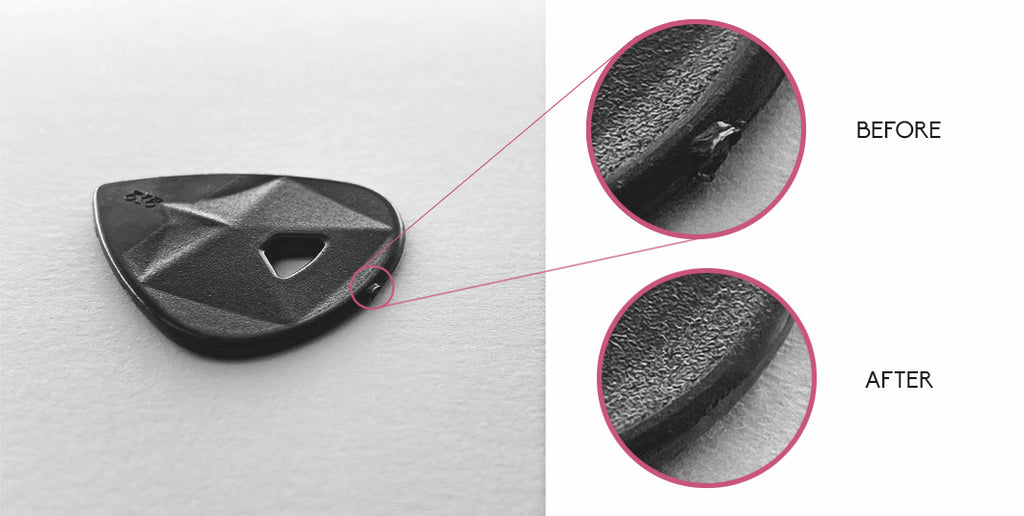
The borders of the pick have a parting line which is also removed post-production to increase the quality of the borders of the guitar pick.

Rombo Diamond is manufactured by automatic processes. However, a post treatment by hand is necessary to achieve the quality Rombo pursues.
4 - Guitar pick sound
Guitar Pick tone
So far, we have defined Rombo Diamond as a very thick, small-medium guitar pick, with a sharp tip. These are the typical characteristics of a pick that produces very bright tones.
However, due to the variable thickness mentioned before, we incremented the dynamic range of the guitar pick, allowing the player to enjoy some bass dark tones as well.
Usually, guitar picks with a very heavy attack can reduce the sustain of your guitar tone. With these small thickness changes we solved this problem.
The polished guitar pick tip, combined with its shape, enhances the bright tones and allows you to play some of the harmonic techniques on an electric guitar more easily.
The bevel edge can create those beautiful thick and compressed tones that we all like for distortion and overdrive.
Rombo Diamond is a pick that produces bright and clear tones, but with slightly dark shades in the background, which makes the sound richer and more complete.
Guitar Pick Noise
Because of the integrated bevel edge, the material toughness, the shape, the pointy polished tip, and the thickness, we consider Rombo Diamond to be a guitar pick that creates lower pick noise.

5 - Guitar pick techniques
Rombo Diamond was designed for the advanced player who likes speed, volume, attack, and control, but still wants a sophisticated tone and more than just power.
It is mainly intended for electric guitars.
Arpeggios and shred techniques like sweep, alternate, and tremolo picking are good examples of techniques which can be improved using the right guitar picks.
For strumming and palm mute, using Rombo Diamond can give you a much thicker and complete sound creating a bigger atmosphere when playing guitar.
6 - Pricing
Rombo Diamond is currently offered only in guitar pick sets containing four guitar picks in different color combinations and a packaging card with extra information about the pick attributes.
This pick is also included in the Variety Pack from Rombo, with other guitar pick models.
7 - Conclusion
Size: Small-Medium
Shape: Pointy tip, sharp attack angle
Thickness: Heavy with variable thickness. Hold area: 2,65 mm - Attack area: 1,35 mm
Materials: Rombo Polymer and EcoBlack
Durability: Very high
Design: Diamond Design with two different surface types.
Grip: Medium, micro-nodules combined with 3D Surfaces
Colors available: Graphite Black, Water Blue, Strawberry Red, Honey Yellow, EcoBlack
Manufacturing technique: Injection moulding and hand processing of the borders.
Tone: Bright, clear tones with a bass nuance on the background caused by the geometry.
Pick noise: Low
Techniques: Mostly electric guitar. Lead guitar techniques and high volume distortion.
Pricing: Guitar Pick Set Rombo Diamond

Inside Rombo Guitar Picks: Guitar Picks developed and engineered in Germany
This article was created because you asked for it. It is meant to be as transparent as possible, so that you can see who the faces behind Rombo are and how we organize this project internally.
We hope you enjoy it!
Rombo Guitar Picks: Short Introduction
Since 2019, Rombo has been researching surface finish and design in order to find the perfect balance between grip, ergonomics, and function in guitar picks and other guitar accessories. Rombo was born thanks to an amazing guitar player community whose aim is to continue this adventure and quest for the perfect guitar accessories.
Who are the faces behind Rombo Guitar Picks?
We are Judith and Carlos, a happily married couple trying to innovate in the world of guitar picks. We live near Stuttgart, Germany.

We both love music, guitars, product development, challenges, and attention to detail, so Rombo was the perfect excuse to mix all these things together and have some amazing adventures.
Our location in Remseck a.N., Germany
Packing and shipping of our guitar picks
From Remseck, near Stuttgart in Germany, we do almost everything.
Here, we receive the packaging and the dots we use to fix the guitar picks to the packaging. We try to be very organized and keep the place very tidy. Tidy places also look better for photographs!

In the shipping station, there is one tray for every guitar pick model. We also include a flyer and a “thank you”-card with every delivery. This way we make the experience more personal, while sharing our journey of packing your guitar picks directly with you!

We have a label printer, which is super useful, and thankfully our web system allows us to automate the printing for every customer and create a label with just one click.
Our post carrier receives the boxes from us with all the information they need to bring our products to you, including weight, countries, and import information for the customs.

We ship every order directly from our location.
The envelopes we use are not very cheap, but they protect the product well, they are made of 100% recycled paper and they are plastic free.

Always learning something new
We have to be very multifaceted to cover all the tasks we do, from idea generation, product development, graphic design, photography, web maintenance, logistics, social media, packaging development, and accounting, to all the stuff a start-up involves.

We believe that doing everything by ourselves gives us a very close perspective from the customer side.
This means, when you ask something on Instagram or Facebook, you receive an e-mail from us, or we answer your comment. It is us behind the screen typing every word and every smiley!

We love walking a lot. We go for a walk for 5 kilometres almost everyday. Almost every idea we applied to Rombo was created while having a walk. We called it our daily inspiration walk.

Rombo is a long journey
Two years ago, at the very beginning of this journey, we could not have imagined how many things we needed to learn!
We have encountered many challenges on the way; for example, I remember it was very difficult to find out how to sell internationally and establish a system that is fast enough for us.

I cannot tell how many books on startups, online marketing, Kickstarter or time management we have read! One of the most useful ones was A Crowdfunder's Strategy Guide: Build a Better Business by Building Community, by Jamey Stegmeier.
A funny anecdote is that Judith and I don’t have our own Instagram profiles. For the first post from Rombo, we had to check out a tutorial on Youtube to try to understand the process. I am glad to say that two years later, we have reached almost 20K followers!
PS: We still don’t have our own accounts, the one for Rombo is enough work! :)
Guitar picks: All about the design process
The most complex part is the design process of a guitar pick.
I like to sketch a lot, so I have lots of old ideas and sketches which I use as an inspiration source. Sometimes, we use questions to challenge the design process, like “Is it possible to create a guitar pick that is flexible and rigid at the same time?” While trying to answer this question, we came up with the idea of “variable thickness”, which has proven to substantially increase ergonomics.

Since we have an engineering & design background, we also do the modeling in 3D and product engineering. Every detail is important here to create high-quality products.

When we think the design is ready, we create some prototypes and send them to the testers. If you follow us on social media you will know some of the testers from our stories.
In total, we have about 30 guitar players that help us during this phase of the project and communicate with us which points they liked or didn’t like. Thanks to their feedback, we are able to improve areas of the guitar picks which we would otherwise not have thought of.
Manufacturing technologies
For the manufacturing of our guitar picks on a large scale, we use a technology called injection molding.

In this process, the melted raw material is injected into a mold with the negative shape of the guitar picks.
It is a very complex process with lots of engineering in it, the material has to be treated in a special way to keep the proper humidity, temperature and pressure, and to avoid external contaminations.

On the left, the injection mould from Rombo Diamond: Our polimer flows through the mould runner (yellow arrows) after it reaches over 270°C degrees and it is pushed forward.
The red area is the area we use for the grip texture. The blue area is high mirror polished.
On the right: The first ever produced Rombo Origami from 30.11.2018. The first 50 guitar picks we produced were sent to guitar pick testers who gave us feedback about the material, the grip, the tone and the shape.
The raw material we use is produced in Italy. We have worked very closely with our material partner to accomplish every requirement we had, including the 100% recycled material of the EcoBlack sets. If you want to know more about the materials we are using, you can find more information HERE.

Packaging for guitar picks
We believe packaging is a very important aspect of a product. We not only use it to create an atmosphere and emphasize the quality of the product, but also to inform you about the attributes of our guitar picks.

This is the reason we created packaging with lots of printable areas to describe the guitar picks. We include our parameter bars, a short description of the guitar pick, the 6 special attributes of a Rombo guitar pick, and a QR-code with extra information.
We had a total of about 6 different concepts before we decided which one was the most suitable.
Right now, we are creating the packaging layouts for the new models that will launch in 2021. We have received some samples and they look great!


If you want to see the new models, you can click HERE.
Guitar picks and social media:
Rombo product photography:
Carlos takes the pictures for social media. We are not very skilled with the camera, but we have learned a couple of tricks and after thousands of trials, we are able to take decent pictures in our living room.

In our Instagram you can find the best pictures.
Educating the customer
You have probably noticed that our posts on Instagram are mainly informative. Guitar picks are often underrated and most guitar players don’t think much about it.
However, guitar picks are the loudest amplifier you can have in your hands and are the bridge between you and your guitar.

We try to pass the know-how we have obtained directly to you, so you can make conscious decisions about the products you purchase. Aspects like the variations on the tone depending on guitar pick thickness, or why are there so many guitar pick shapes and materials… And this is the reason we created our blog articles.
Our aim is to create a communication process that goes back and forth between us. Some of you have become friends of ours and have won a new perspective of thinking about guitar picks.
Engagement of the community
“To listen closely and reply well is the highest perfection we are able to attain in the art of conversation.” – François de La Rochefoucauld, essayist.
We believe we have one of the most engaged communities ever! We try to answer every comment and every private message, and we are sure we have an answer rate very close to 100%.
You all have participated in surveys, and you have left amazing comments and reviews. You post stories regularly and we have had very deep conversations with some of you! Thank you!
We also received great support from many amazing blogs like Heavy Repping, Gigs and Guitars, The Gadget Flow, Ultimate-Guitar, Guitar World, and others.
Rombo around the world
Rombo is expanding. We are working with dealers around the world and currently we have sellers in the following countries:

This means, with the help of our dealers we are able to sell in Europe, North America, Asia, Australia, almost every country of South America, and South Africa.
Transparent communication with our dealers is a priority with us, and so far 100% of the new sellers stay with us! Together we are developing the brand and taking it to the next step.
The future of rombo:
During our inspiration walks, we talk about Rombo in the next few years. It is very difficult to imagine what the future will bring.
We would like to bring new designs (lots of them!), to increase the amount of recycled material for the manufacturing of the picks, or even be able to create colored recycled guitar picks. We want to talk more to our customers and share our experiences, and from time to time, share some great music and playlists.
We are only two people and every step takes its time. Some of you have written beautiful thank you letters to us or left very good reviews and we want to let you know that we are working hard everyday not to disappoint you :)
You are the best and you have a vote on the future of Rombo!

Guitar Pick Durability: Everything You Need To Know
The guitar pick has been in constant evolution since the 1920s.
Today, 100 years later, we have achieved great accomplishments in the area of durability of this very important piece of guitar gear.
In this article, we will review all the important points that can cause picks to wear out, and summarize all you need to know about guitar pick durability.
We will make some comments on the tone, to help control the changes, which happen after a guitar pick has worn down.
In addition, we will give some advice to keep your picks “healthier“, longer than expected.
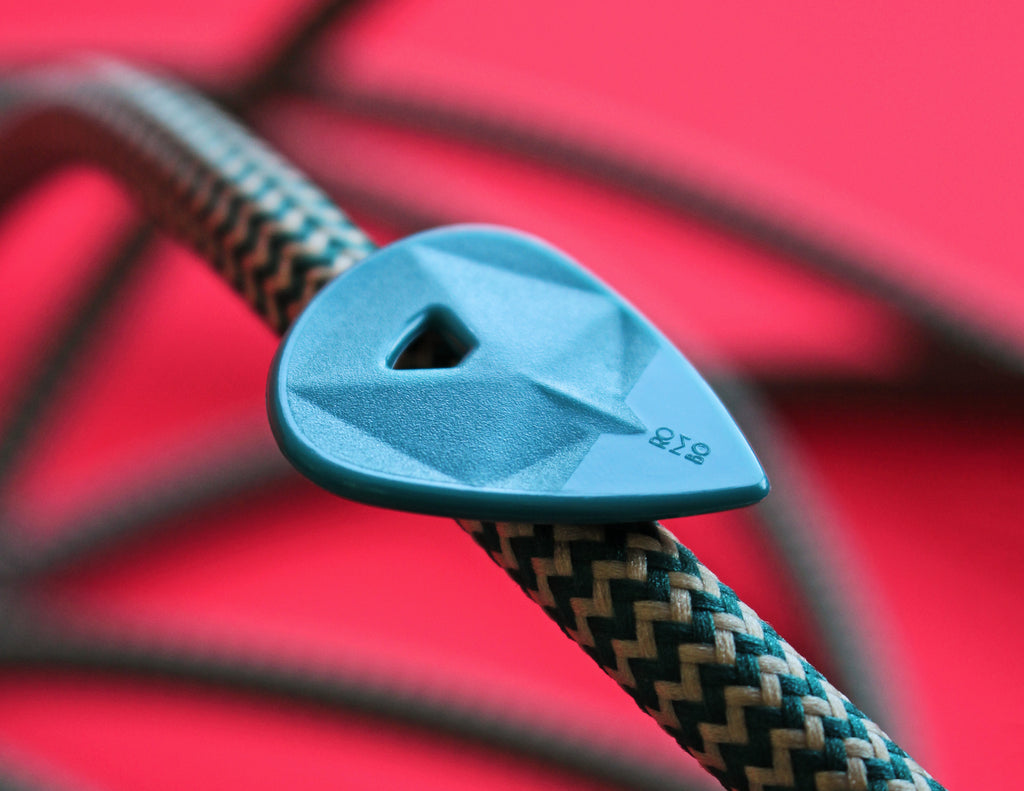
New vs. Old (worn down) Guitar Picks: Tone Changes
We all know that using different guitar picks, will also make a difference in your tone, and your playing. Material, shape, thickness and shape of the pick, directly affect the tone and playability.
Most standard plectrums can resist heavy strumming for a long time, without much wear and tear.
The first thing you may notice after using a guitar pick for some weeks, is that the tip is not as pointy as the new guitar pick. You will see it, and you will hear it, because the tone of the pick will change over time, with wear.


The rounded shape of the worn down plectrum, will create warmer tones, and feel darker. This is totally fine, if this is the tone you are looking for.
It will also affect the way your plectrum plucks the strings:

Just like the guitar strings, the frets, & other components, the guitar picks will wear out over time.
Some players feel a lack of control after the guitar pick has worn down, while others use the rounder picks because of the tone they produce. This especially happens to jazz guitarists, who tend to choose picks that are almost circular, for example: Rombo Waves.
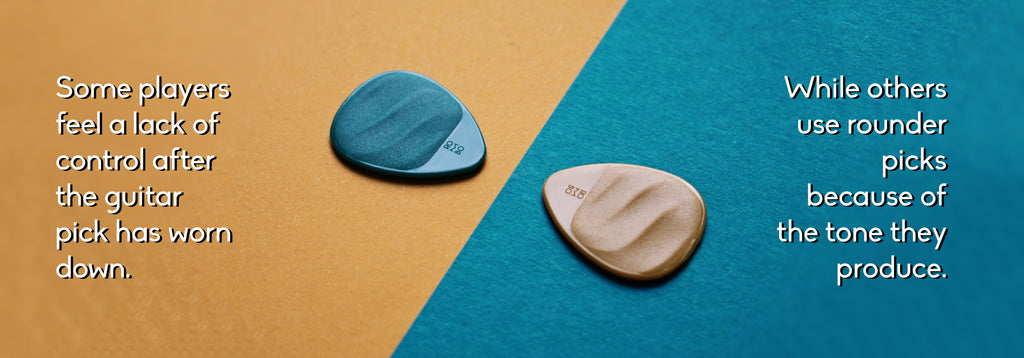
Gaining control when using rounder guitar picks, is an ability you can train yourself to do, and improve.
Why Can’t Picks Last Forever?
Guitar strings are usually made from a mix of steel, nickel, bronze, or brass. In other words: Metals.
Since most players use some kind of plastic material for their guitar picks, (nylon, delrin, …), it’s not surprising that friction between strings and picks will cause the guitar picks to wear down.
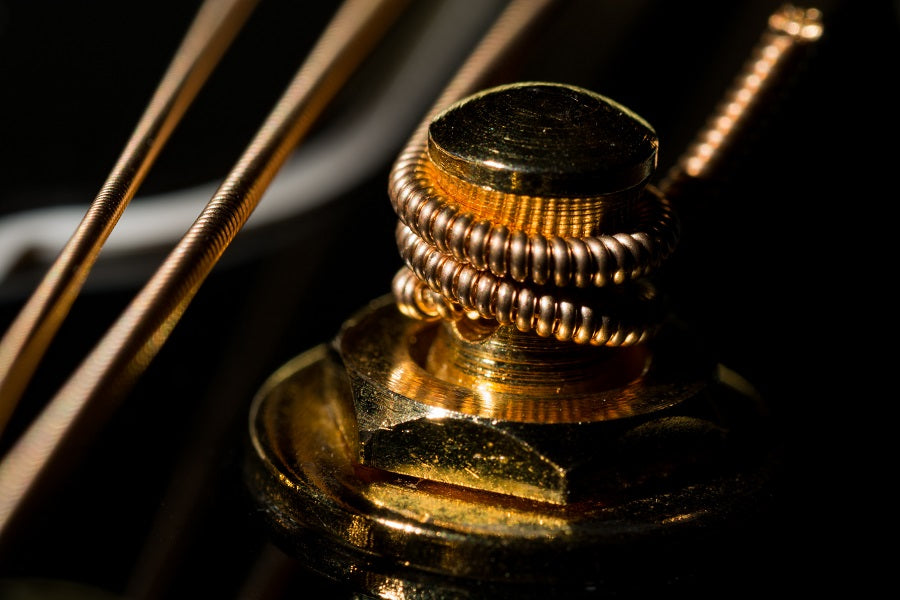
You will notice, the thickest guitar strings have a spiral wire wrapped-around, acting like a sanding file on the plectrum.
Guitar Pick Durability: How Long Should a Guitar Pick Last?
The short answer: If you are an average user, your picks should last a few weeks to a month. If you are a professional player, using specific techniques, like heavy picking and strumming, it will probably last just one day, especially if you are a studio musician recording new tracks every day.
The long answer: This answer includes many factors including guitar pick attributes, and external factors, regardless of the guitar pick you are using. We discuss all of them below.
Guitar Pick Attributes That Directly Affect the Durability
The attributes that define the durability of a guitar pick are as follows:
- Guitar Pick Material
- Guitar Pick Thickness
- Guitar Pick Tip Shape
- Guitar Pick Tip Texture
Harder materials will wear down slower. This is one of the reasons there has been a lot of research in the area of suitable materials for guitar picks.
The goal is to find a wear-resistant material, that keeps the tone characteristics that guitar players want, while still giving a good grip.
However, material is not all. The thickness of a guitar pick will enormously affect the wear and tear. Thinner picks will wear down almost immediately when using heavy pick techniques.

Other attributes of the pick that affect the durability, are the Tip Shape, and the Tip Texture. Very pointed guitar tips tend to wear down faster, because there is less material on the tip.
However, this problem can be partially solved with the right guitar pick tip texture. A polished tip on the guitar pick will cause less friction between strings and plectrum. This is one of the most underrated attributes of a guitar pick, and you can find more information HERE.
What Damages the Pick the Most?
Results show, that the best way of altering and degrading the shape of your plectrums is to perform “pick slides”.
This guitar technique will wear away the edges of your plectrum and will make it useless very quickly.
This won’t directly affect the tone or control of the plectrum, but the damaged sides will contain some dents. The plectrum will get stuck either on the up stroke or the down stroke.
External Factors Which Indirectly Affect the Durability
It’s not only the guitar pick quality that is responsible for its‘ damage. There are three more factors that can play a role on the durability:
- Hours of guitar training
- Guitar strings gauge
- Guitar playing style and used techniques
It is a very simple equation: The more hours you practice, the more your picks will get damaged.
Thicker guitar strings will increase the area of contact with your plectrum, and therefore, wear it down much faster.
Aggressive guitar playing techniques, like fast palm mute, or pick slides, will damage your guitar pick very easily.

How to know if a Pick is Durable?
The best way to find out, is to test it, and make your own judgment.
You can take advice of expert players, who have tested lots of guitar picks. However, if their playing styles differ from yours, this information won’t help much.
Besides, many expert players have not changed their picks for decades, and they might be missing the material improvements of the last decade.
As mentioned, not only is durability a factor to take into account when choosing a guitar pick, but also the tone and the ergonomics (grip, size,...).
How to Know When to Replace Your Pick?
If the edges of your pick are becoming more rounded, you might start to consider purchasing a new one.
However, never throw away your worn-down guitar picks! The rounded edges can be used to create more mellow tones, and you might want these for some of your songs.
One of the most important things about playing the guitar, is to keep your mind open to new tones and styles. This is the reason some guitar picks have rounded tips even when they are new.

In addition, you can store your old guitar picks in a box. I wish I still had my first guitar pick, that I used, when I was learned to play guitar as a child. A guitar pick can be a beautiful piece of your past.
Check Your Pick Condition Regularly
A tip from my side, is to double check every guitar pick before going out on stage, or studio. A visual inspection is fine.
Always keep some unused plectrums aside. Considering plectrums are probably the least expensive gear of your complete guitar rig, constant wear and tear issues is not a thing you should worry about.

Choose your ideal Plectrum
Are you using the right pick? This is a question you should ask yourself every time you play a song.
Some players have their 5-favourites, depending on the style and type of guitar they want to play.
The most important factors when choosing the right plectrum for you hinges on….
- Material
- Shape
- Thickness
- Size
- Playing style
- Your personal preference
We created a guide that will help you find the right plectrum for you.
You can find it HERE.
Thank you!
The support we are getting from the guitar community makes us very happy!
We, (Carlos and Judith), are really doing our best to create the best guitar picks for you.
If you consider supporting a small family start-up, you can share this article and directly have an influence on our online visibility.
These small actions have helped us since January 2019, and we count on your support! :)

Thanks!

6 Underrated Features Of A Guitar pick
In our article “How to choose the right guitar pick”, I summarized the aspects you should care about and consider when deciding which plectrum to use.
In this article, we will discuss the characteristics of a guitar pick we must pay attention to in order to make the playing experience much more comfortable and obtain better results. These aspects are not as obvious as others but are essential to get the most out of this incredible musical instrument.

1- Guitar Picks with Micronodules Grip Structure:
Grippy, non-sticky surfaces are perfect for the hold area on a guitar pick. The best way to achieve this is to create a texture, that fits between the grooves of your skin and prevents the guitar pick from slipping or creating an aggressive grip geometry that hurts the fingers of the guitarist.

2- High Mirror Polished Tip:
A guitar pick with a polished tip allows you to experience better control and less friction. In this way, reduced friction between the plectrum and the strings of the guitar will help increase the durability of the pick because it will wear less and reduce its noise.

3- Variable Thickness:
One of the less common characteristics in guitar picks is variable thickness. It is ideal for the guitar pick to be thick for better control; however, this could significantly reduce its flexibility.
For that reason, plectrums of variable thickness have been created, since this would give us the best of both aspects.
That is to say, we could have a guitar pick with a solid, thick body that gives us better grip. Additionally, it features a thinner tip that provides enough flexibility to achieve greater versatility when developing different guitar techniques.

Read more about the advantages of using a guitar pick with variable thickness in our article "5 advantages of a guitar pick with variable thickness"
4- Ergonomic Design Surfaces:
By following ergonomic models, the surface of the pick can be adapted to be comfortable, provide well-being and does not hurt the guitarist's fingers. It is advisable to look for picks with a 3D surface (those that are not flat) that have geometric patterns that offer a pleasant feeling to the grip. Similarly, we can take advantage of concave or convex surfaces, as they help keep the position of the plectrum oriented and avoid losing control in turning movements.
5- High-quality materials:
If your hands do an arduous job, then you must give them the right tools, right? Many people spend a lot of money on fancy guitars, cables, amplifiers, and other accessories but set aside the pick. This is a big mistake.
The material with which it is made can influence the definition of tone, attack, and flexibility. Therefore, without paying attention to it, you could hardly find your personal sound.
Are you curious about the materials used for the Rombo guitar picks?
Read a full article about it here:
https://rombopicks.com/blogs/insight-rombo/guitar-pick-materials-at-rombo
6- Unique Designs:
If you want to project an image with your own style, you must pay close attention to the design of your implements. To do this, you can try all the shapes and colors of guitar picks available in the market. Just imagine having one with an incredible appearance that is also very functional.

Conclusion:
In short, all aspects are subjective and depend on each person. Nevertheless, knowing such valuable information can expand our possibilities and options to choose the guitar pick that best suits our needs.
Tell us if you think this data can help you during the learning process of playing guitar and let us know if there are any other details about guitar picks that you think we should consider.
PS: Remember, you should share your skills with the world. In the article, “MUSIC AND DIY GENERATION”, I explain how the Internet community of guitarists helped me understand the importance of sharing my work.

ROMBO Unveils New “Eco-Black Range” Guitar Pick Models
Guitar Picks Made Out of 100% Pre-consumer Fibre Waste
Rombo Picks has unveiled a new series of plectrums made out of 100% recycled waste. The material is not only environmentally friendly, but also has high mechanical strength and stiffness, excellent impact resistance and superior aesthetic properties.

Rombo uses this material for its Eco-Black range. In this range, all four guitar pick models are available only in Graphite Black, which is one of the properties of the recycled material. Each pick has been carefully developed for a concrete purpose.
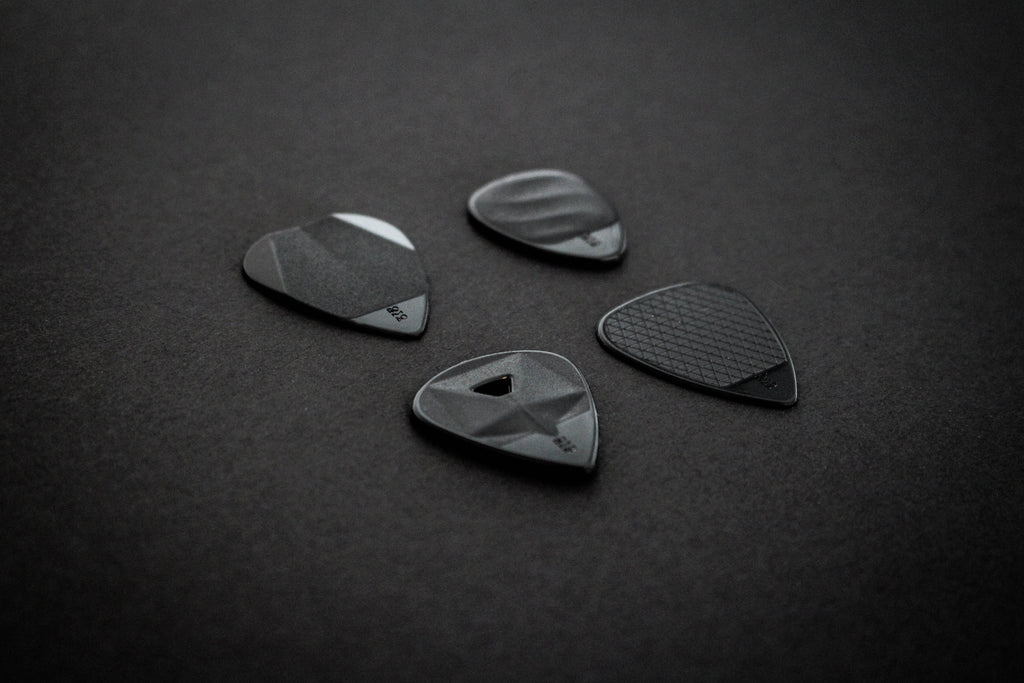
For this reason, the Rombo team has redefined the four attributes of a guitar pick: shape, thickness, material and size.
The Highlights of These Guitar Picks Are:
- Micro-nodule grip structure
- High mirror polished tip
- 3D ergonomic design surface
- Variable thickness
- High-Quality materials
- Unique designs

Since 2019 Rombo has been researching surface finish and design in order to find the perfect balance between grip, ergonomics and function in guitar picks. Rombo was born thanks to an amazing guitar player community whose aim is to continue this adventure and quest for the perfect guitar pick.
We have a full article about the materials used for the manufacturing of the Rombo guitar picks here:
https://rombopicks.com/blogs/insight-rombo/guitar-pick-materials-at-rombo
Did you found this article useful? Please share it with your friends!
Do you think these features are important attributes for guitar picks?
What do you think about the material we are using for this range?
- Shop
- Dealers
- Legal Notice
- Terms of Service
- Refund Policy
- Shipping
- Privacy Policy
- Contact us
- Press
- FAQ
Sign up to get the latest on sales, new releases and more…
By signing up you agree to our privacy policy.
© 2025 ROMBO.
registered brand
Powered by Shopify


